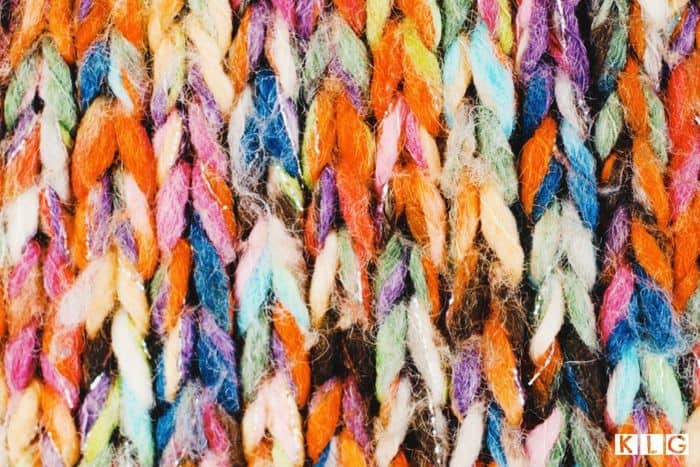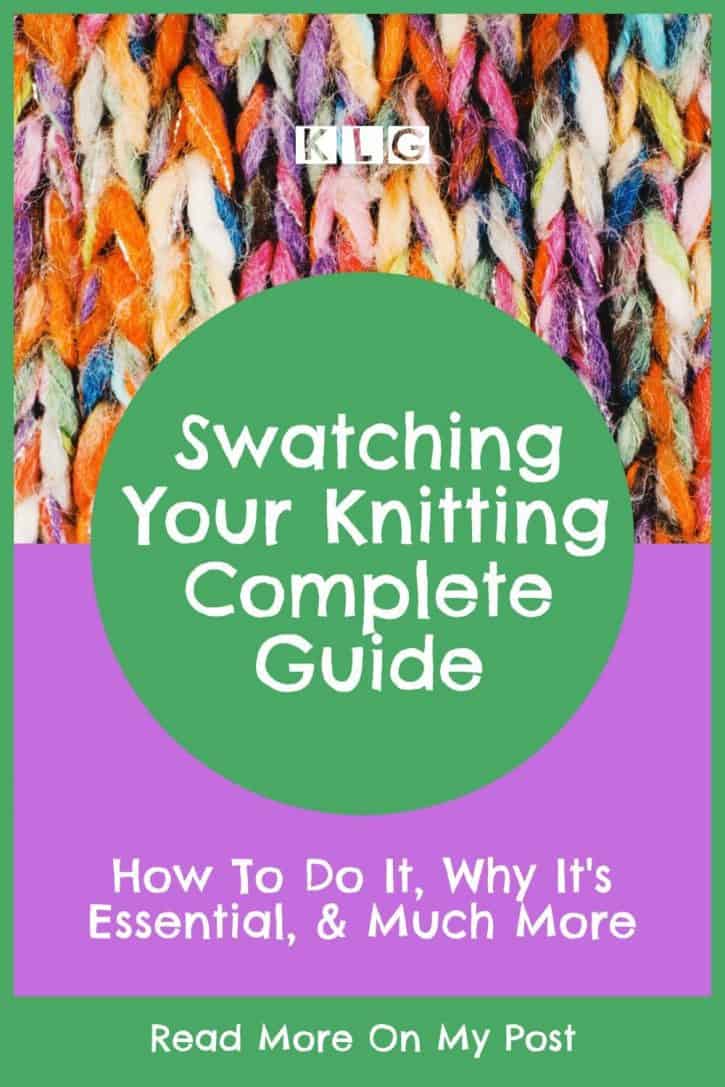Swatching! A skill every knitter needs. A gauge swatch is an essential step in the process of knitting a garment or doing a project you’ve never done before. In this blog post, I answer what swatching means, how to knit a gauge swatch, and much more. Here is my complete guide to swatching knitting.

Table Of Contents
- What Is A Swatch In Knitting?
- Why Should You Swatch?
- How Do You Do A Swatch Test In Knitting?
- How Do You Swatch In The Round?
- Measuring Your Finished Gauge Swatch
- Blocking Your Swatches
- Different Methods Of Swatching
- FAQS
I reviewed, fact checked and updated this post on May 28, 2023.
What Is A Swatch In Knitting?
A swatch in knitting is a sample knitted piece of a bigger project or garment. Think of it as a prototype or first attempt before tackling the real thing. It resembles a piece of the finished fabric as closely as possible to ensure everything is working properly.
Benefits Of Swatching
You should swatch because it saves you a lot of pain and time as you test out the yarn and pattern, to get familiar with it and how it works. Every knitter also has a different gauge, and to properly knit something, your gauge needs to fit with the pattern gauge stitch pattern you’re working from.
I know it’s tempting to start without doing a swatch, but don’t! The minutes you save aren’t worth it. If you can afford it, buy an extra ball of yarn to knit a swatch.
Here’s a list of the benefits of swatching.
- Far less stressful! With this handy technique, you’re saving your future self pain and time.
- You get to practice knitting a stitch pattern you’re unfamiliar with, and you can decide if you like doing it before committing to the full project.
- You also learn and improve before attempting the real thing, fewer mistakes, and pulling out!
- If you’re using a yarn fiber you haven’t used before, knitting a swatch is great to gain experience.
- Catch any anomalies or difficulties the yarn presents!
- If you’re making a fitted garment, for example, a sweater, this step becomes even more important. You wouldn’t want to spend all that time making a sweater only for it to fit incorrectly or the border to be all wrong!
Here’s a video on why you should swatch by The Chilly Dog.
How Do You Do A Swatch Test In Knitting?
Here is how you knit a gauge swatch in knitting. (Note: These instructions apply to all stitch patterns, including knit and purl stitches.) Set aside some time to do the swatch. This is essential!
As your gauge swatch needs to resemble the finished garment as closely as possible, you need to use everything you would for the real project. Including yarn, knitting needle size, stitches per 4″.
Decide what size gauge swatches you’ll be doing. Most knitting patterns recommend enough stitches to make a 4″ square, but many knitters recommend a gauge swatch of 6 or 8″.
Cast on the correct amount of stitches onto your needles, as directed by your yarn label or the pattern you’re using. (If you’re using stockinette stitch, make a few extra stitches in knit stitch (garter stitch) on each end of every row.)
(Also, a few on the top and bottom of your project. This stops the stockinette stitch from curling and ensures more accurate measurement.) Knit your first stitch and your square according to the pattern project you’ve chosen.
Don’t even think about measuring it before you’ve cast off and blocked it! The measurements on the needles will be vastly different from a finished item.
Cast off according to the instructions, and if you’re going to block your project, then do that! Do it the way the pattern instructs you to. Many knitters can’t stress the importance of this enough.
Measure the finished item once it’s blocked and dry. This step is essential! If there are no issues and it’s the right measurement with the right number of stitches, you’re good to go!
If the gauge measurement is too big, do another swatch with a smaller needle size to fit the pattern gauge. If the gauge measurement is too small, do a swatch with a bigger needle size.
Pin For Later

How Do You Swatch In The Round?
To swatch in the round, you follow the pattern project normally, using the correct yarn, knitting needles, and stitch patterns. One of the best methods for swatching in the round is speed swatching. Here is how it’s done.
- Using your circular needles, cast on the necessary number of stitches.
- Knit one row
- Don’t join the round, but instead, slip the live stitches back to the needle’s right tip.
- Bring the yarn to the other end across the back and knit the first stitch. (You’ll leave a long tail of yarn, but don’t worry about this, it simulates the other side if you were knitting in the round.)
- Continue knitting as the stitch pattern says to
- Repeat this sequence for as many rows as needed.
- Cast off
- If it needs to be blocked, block it, and let it dry.
- Measure the finished swatch.
- If everything is good, you’re set to go!
Measuring Your Finished Gauge Swatch
Here’s how to measure your gauge swatch and check your stitches and rows are the correct amount per inch.
- Place your swatch on a flat, clean surface.
- Get a ruler, and use it to count the number of stitches within the 4 inches, in the center of the knitted fabric length.
- (Ideally, use a flat, inflexible ruler rather than measuring tape as it will be slightly more accurate.)
- The number of stitches you get is your stitches per 4 inches gauge. Divide the number of stitches by 4 to get your stitches per 1-inch gauge.
- To measure your row gauge (row count), rotate the ruler so it’s straight up and down the knitted fabric’s length. Align it with the very top of the swatch. Count the number of rows per the length of four inches.
How Do You Measure Knitting In The Round?
If you use the speed swatch method, use the same method outlined above for measuring gauge knitting in the round. If you measure something that isn’t a swatch, say a cowl, follow these instructions.
- Lay the swatch flat as you can and smooth it out.
- Perhaps use something to hold it in place.
- To get the length, measure from one end to the other, and multiply that number by two to get the full length.
- To get the width, measure it from top to bottom, and multiply that number by two to get the full width.
Blocking Your Swatches
I can’t stress how important it is to block your swatches. I’d highly recommend waiting 12-24 hours after it’s dried and you’ve unpinned it before measuring it. This is to ensure the measurement is the most accurate it can be.
Different Methods Of Swatching
There are two methods of swatching, both of which are outlined in this article. One is the normal one, for use when knitting flat and the other is speed swatch, for knitting in the round. Here’s a video for more by Very Pink Knits.
Swatching Fair Isle
Here’s an excellent tutorial on how to swatch yarn for fair isle.
Swatching For Colorwork
Check to ensure you knit a swatch for when you’re working with multiple colors. Check all the things you do when you make a swatch and check how you want the colors to look.
Unless you absolutely love how the colors are set out in the knitting pattern, you need to make a gauge swatch to see what order you want the color to be in.
FAQS About Swatching
Swatch Knitting Tips
Here is a list of handy tips for making a swatch much easier!
- Knit a swatch that’s bigger than you think is needed. It’s safer that way, and you get more practice,
- Make sure you use the same needle size and yarn when making a gauge swatch as when you’d knit the final project!
Here are more tips for doing a swatch from The Blue Mouse.
Do You Have To Match The Pattern’s Gauge?
Yes. Otherwise, the knitted item will look strange and won’t fit properly if it’s a clothing item. Knitwear designers tell you if the gauge isn’t as important for example a knitted shawl.
What Do You Do With Your Swatches?
After doing a few knitting projects, you can end up with quite a few swatches. Here’s what to do with swatches.
- Tie a ribbon around the middle and make a decorative bow!
- Sew it onto a bag or into a bag for a textured pocket.
- If it’s not too holey, fold it in half, sew it up and make a doll’s cushion or sachet to keep drawers and cupboards smelling fresh.
- Turn them into baskets to hold small items.
- Make it into a scrappy blanket or lapghan!
- If you’re particularly proud of it, frame it.
- If you have multiple, turn it into bunting and hang it up in your craft room.
- Learn how to turn a swatch into a bracelet.
- Turn several of them into a bag or tote.
How Do I Know How Many Stitches To Cast On?
The pattern you’re working from will tell you how many stitches to cast on.
How Does Blocking Affect Gauge?
In general, blocking stretches out and relaxes the fabric, and the swatch gauge size changes. So if you were to measure something before and after blocking, you would get quite different results!
What If My Row Gauge Is Off?
You’ll need to use a bigger needle size or smaller needle size if your row gauge is off.
How Many Stitches Does A Swatch Have?
It varies, depending on many factors. The pattern you use will tell you how many you have to cast on.
How Does Knitting In The Round Affect Gauge?
People tend to knit tighter and have a smaller knitting tension in the round, so the same amount of stitches in a knitted flat piece and a knitted in the round swatch will be smaller in the latter.
Many people find something knitted in the round feels heavier or denser too. This even applies if you use the same pattern for knitting flat and round! Be prepared to go up a needle size when knitting in the round.
Do You Block A Gauge Swatch?
You should block a gauge swatch, as you need the size of the swatched fabric as close to the pattern guidelines as possible.
How Big Should Gauge Swatch Be?
Most knitters recommend either a 4 inch, a 6 inch, or an 8-inch size square. As a rule, it’s better to go bigger than smaller.
Conclusion
I hope you found this guide to gauge swatch knitting helpful. An essential skill and step in learning to knit, this will help you knit all sorts of gorgeous knitting patterns correctly and with a lovely outcome. Enjoy your making, swatcher!
Read Next: Indulge in a pair of premium needles for yourself (or your favorite person) using my guide here.
About The Author
Jodie Morgan (Author & Founder)
jodie@knitlikegranny.com | Lives In: Regional Australia
Author: Jodie Morgan is a passionate knitter and blogger with 40+ years of experience currently living in regional Australia. Taught by her mother and wonderful grandmother “Mama”, she fell in love with crafting from a young age. When she’s not knitting, you’ll find her enjoying a cup of coffee with cream, or sharing helpful resources and tips with the online knitting community. Get to know Jodie and the team on our meet the team page.
Crunchbase | LinkedIn | MuckRack | Ravelry | Twitter